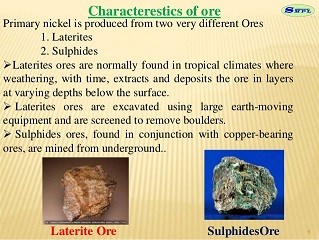Garnierite is a general name for a green nickel ore which is found in pockets and veins within weathered and serpentinized ultramafic rocks. It forms by lateritic weathering of ultramafic rocks and occurs in many nickel laterite deposits in the world. It is an important nickel ore, having a large weight percent NiO. As garnierite is not a valid mineral name according to the Commission on New Minerals, Nomenclature and Classification (CNMNC), no definite composition or formula has been universally adopted.

Nickel Laterites: The World’s Largest Source of Nickel
Nickel is found in two types of deposits; Nickel laterites and magmatic sulfide deposits. Although nickel Laterites make up 70% of the world’s nickel reserves, few of them become producing mines. Over the last 60 years magmatic sulfide nickel deposits produced 60% of the world’s nickel. In the last 10 years, the production of nickel from magmatic sulfide deposits has slowly decreased and begun to plateau. With the global consumption of nickel growing at a rate of 4% per year (and increasing), it has now become apparent that new sources of nickel need to be found.
Laterites are a type of soil, rich in aluminium, magnesium, iron or in this case nickel that formed through prolonged chemical and mechanical weathering in wet, warm, tropical environments. The name “laterite” is a derivative of the latin word later, or “brick”. A long time ago, bricks were carved out of laterites and used as building material in Asian countries such as India and Cambodia.
Physical Characteristics
Nickel Laterites are composed of long tabular bodies, over several hundred meters, but only tens of meters deep. These deposits develop from the mechanical and chemical breakdown of high temperature igneous rocks known as ultramafic rocks. These deposits consist of a predictable weathering profile that includes five “zones”: The un-weathered ultramafic bedrock, the weathered bedrock or “saprolite”, a clay-rich layer, limonite zone and a ferricrust or “iron cap”. Economic laterite deposits tend to form in areas of low topographic relief as the difference in elevation can have an effect on the thickness of the deposit.
The average grade and tonnage of nickel –cobalt bearing laterites is 1.3 % Ni and 0.04% Cobalt at 56 Million tonnes. Middle grade Ni deposits contain more than 1.5% Ni and high grade Ni deposits are greater than 1.8%.
How do they form?
Many factors affect the formation of nickel laterites, including the original rock the soil develops from, the climate, the rate in which weathering occurs, drainage of groundwater and the tectonic setting. The nickel in these laterites is sourced from the ultramafic bedrock. Ultramafic rocks are deep-sourced high temperature igneous rocks that tend to form within the earth’s mantle or at the base of sequences of oceanic crust. Large scale tectonic events uplift these sequences to the surface and emplace them onto the continental crust. Though these rocks don’t contain a lot of nickel (up to about 0.3%) the soil formed above these rocks is slowly enriched in nickel as the more soluble elements are carried away. Given enough time, these lateritic soils can contain up to 5% Nickel!
Goro Nickel Mine, New Caledonia
The Goro Nickel Mine is one of the world’s largest Nickel Laterite Mines. The mine has a mineral reserve of 124 million tonnes, with an average nickel content of 1.48% and a cobalt content of 0.11%. The mine began production in 2010 and has a capacity of 60,000 tonnes per year.